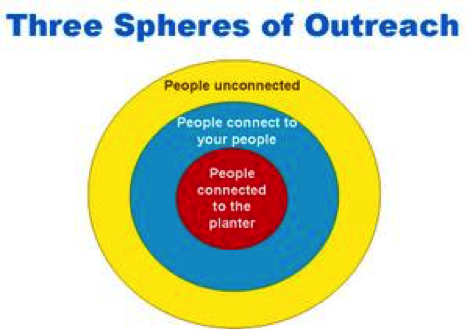Legendary football coach Paul ‘Bear’ Bryant said, “Have a plan. Follow the plan, and you’ll be surprised how successful you can be. Most people don’t have a plan. That’s why it’s is easy to beat most folks.” In a recent survey, it was revealed that 79% of churches have no, to little, plans for fall outreach. This may be the reason why 80-85% of the churches in America are either plateaued or declining. Designing, executing and implementing outreach plans and strategies is one of the skills pastors need for creating positive momentum in their churches.
Here are a couple of insights that you can apply to plan your fall growth thrust.
1. Develop a team.
Too many pastors try to carry the load all by themselves, which is an unbiblical notion. Christianity is a team sport. Team building is one of the skills successful pastors need in their tool belts. Learning to pick the right players on your team is crucial. Guiding and leading the team is imperative. Trusting the team to execute the plan is empowering. Celebrating and encouraging the team is vital. I encourage pastors to use short-term task forces with a specific task along with a starting and ending point. If you built a task force for each of your major outreach initiatives for fall, winter and spring your team building skills would improve each time. Team building is a skill which is honed through the “learning by doing” process.
Getting key influencers involved in the process is vital to building positive momentum.
2. Develop a timeline.
To develop a good timeline, start with the last date of the project and work backward. If you are doing a fall growth push here are a couple of ideas. End your fall outreach campaign on the first weekend in November with a family friendly comeback event and start July first with the selection of the team. This is what I call the “three-month rule” which is to begin the detailed planning process at least three months before the launch of the outreach campaign. Here is an overview of what would happen in those
three months:
- November
- Celebrate and evaluate progress
- Family-friendly comeback event
- Membership class offered
- October
- Newcomers luncheon set
- Bible 101 or seeker study offered
- Small groups launched around the theme
- Sunday worship theme launched
- Second Touch teams equipped and empowered
- September
- Teaching series on outreach and prayer launched
- Prayer walking implemented
- Affinity groups launched – youth, singles, men’s & women’s ministries
- Executing marketing plan
- Equipping congregation with promotional tools
- August
- A clear call to prayer made to the entire congregation
- Prayer emphasis kick off
- Marketing and promotional plan set
- Marketing and promotional tools sent to the printer
- Small group leaders trained and prepared
- July
- Team selected
- Theme developed
- Promotional strategy selected
- Graphic images & promotional tools designed
3. Brainstorm ideas for delivering strong biblical content that addresses the heart issues of your mission field.
Many pastors struggle with the creative aspects of leadership. I recommend that pastors research and purchase some of the good outreach or spiritual growth campaigns available. Many of these come with timelines, job descriptions, graphics, sermon ideas and small group materials. he key is planning ahead. After the church has done a few of these campaigns, then they can take a shot at developing their own.
4. Raise the spiritual temperature of the church.
It is a must to incorporate a church-wide prayer project for before and during the campaign. One example: Call the church to “pray for five neighbors, for five minutes a day, for five weeks” before the outreach campaign. Another idea would be to mobilize the church to prayer walk your whole community before the campaign. You could also call the church to a season of prayer and fasting.
5. Brainstorm ideas for creating buzz throughout the church and throughout the community.
Work with your team to think of ways to get the word out. I like to use sowing language when it comes to getting the word out to the community. Here is a post on the Sowing and Reaping Principle.
6. Drive the theme throughout the church.
Creating a sense of synergy throughout the church is important. Getting every section of the church moving in the same direction is a momentum building experience that creates positive energy and good morale. So take your theme and drive it throughout the church from seniors to youth, from singles to toddlers!
7. Develop comeback events.
Creating opportunities for new guests to connect relationally, as well as spiritually, is crucial to having a successful outreach campaign. Planning some type of family-friendly event is a great way to get people involved in serving for the first time and connecting relationally with others in the church. Offering entry-level Bible studies like Bible 101 or Christianity 101 within weeks of your outreach campaign is important in providing those next steps for those that are spiritually interested. Finally, you want to offer people an opportunity to connect with the church and its leadership by offering some type of newcomers luncheon or party at the pastor’s event where they hear the story and vision of the church as well as connect relationally with key leaders.
8. Recruit volunteers to fill needed ministry roles.
Doing campaigns is a great opportunity to recruit new volunteers for set up, event planning, children’s ministry, ushers, greeters, follow up, administration, new hosts for small groups, etc.
9. Drive your missional values deeper into the culture of your church.
Remember, anytime you do a campaign it is an opportunity to drive your missional vision and values deeper into the lives of your people. The values of evangelism, community, spiritual dependence and community transformation come alive during the campaign and provide opportunities for personal growth and corporate maturity.




